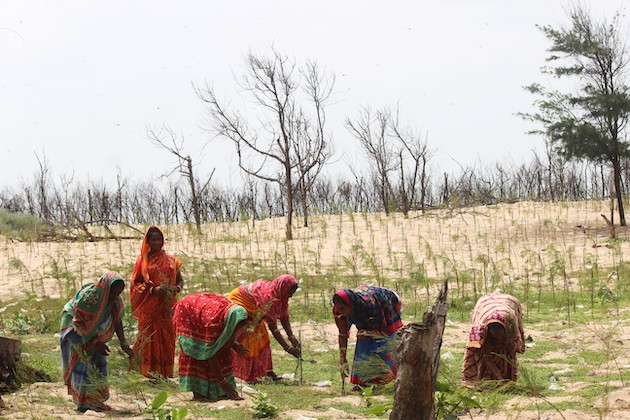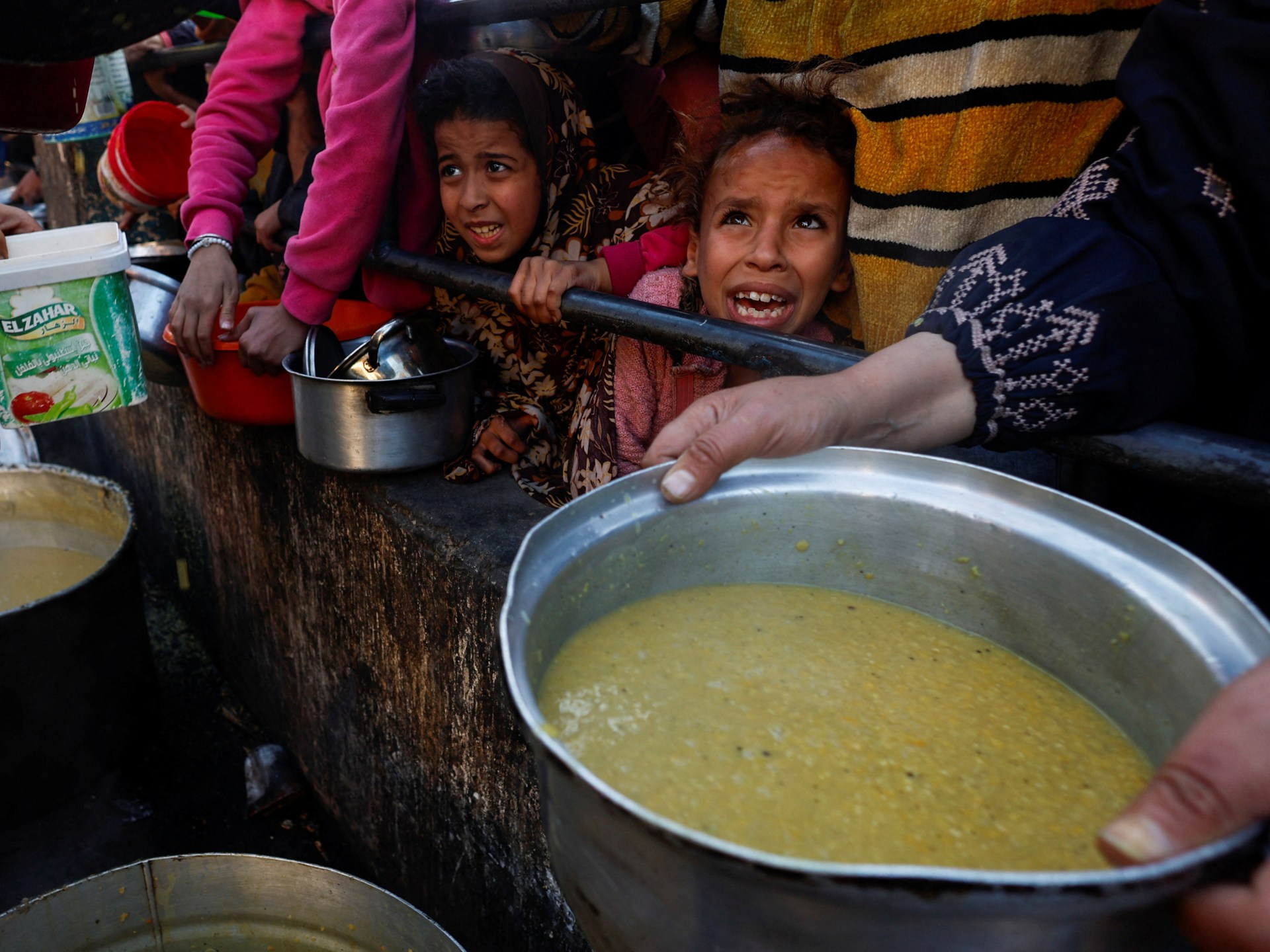The Relentless Struggles of India’s Seawall Mammas — Global Issues
PURI, India, Nov 07 (IPS) – For more than 33 years, a group of strong-willed women from the village of Tandahara, India have kept their homes and village safe and plan to continue despite the unrelenting impacts of increasingly severe monsoons.
The sun is high in the noon sky—humidity unrelenting at 95 percent in this Indian sea-coast village. The monsoon has been deficient; rice paddies are yellowing on the edges from the salty surf misting in on them. Waves now break barely 200 metres from the farms and homes.
Sixty-year-old Bengalata Rout heads for the Casuarina “forest wall” off the shoreline, trees that the women in the 108-household village Tandahara planted after the 1999 Super Cyclonic Storm decimated their mud-walled thatched-roof huts leaving their fertile farms salt-poisoned.
That year, 33 years ago, they planted the trees on the village boundary, a good distance away from the shoreline; today, on a stormy night, the sea crashes against the tree trunks, threatening to run amok into their homes.
Tandahara, sitting on the Bay of Bengal, is one of the last villages in the eastern Indian State Odisha, some 20 kilometres from Konark Sun Temple, UNESCO’s designated heritage site that is itself showing the impacts of seas closing in.
The ‘Big Storm’ Discovery
“When the big cyclone hit us, the Casuarina shelter belt that was standing from before, planted by the government, lay battered,” Rout told Inter Press Service (IPS) as we walked toward the Casuarina forest. “We immediately realised had it not been standing there between the sea and our village we would have been wiped out.”
And it was a life-changing discovery for these rural women.
The category-5 storm, carrying wind speeds of 160 miles hourly that made landfall over Odisha in October 1999, killed more than 10,000 people, mostly owing to 20 ft high storm surges that brought water 16 to 20 miles inland.
But Tandahara had not lost a single life. Losing no time, every woman volunteering, even the children clamouring to pitch in, they sorted themselves into ten groups of ten members with a mix of young and old. Saplings were requested from government and non-profits who came to help. Planting was done; the men lent a hand, but the women took it upon themselves to make sure the saplings survived.
“It was challenging. The soil had salted up, and the young plants struggled to survive,” said Kanaka Behera, 32, one of the younger women. “And the water we got in our village had turned a bit saline also.”
“We thought, for our cooking and drinking, we fetch groundwater from a shallow dug pit; why not get the sweet water for the plants, too? But that was a kilometre inland from our village, more distance from the plantation in the opposite direction. We will do it, we decided and dug the pit wider to get more water,” Behera added.
“For months till the plants survived, we would be up before the sun, lining up our buckets around the water pit where water replenishes naturally overnight. Then the real arduous work began,” said middle-aged Bena Mallika dressed in a bright green sari. Some ten of them would fill the buckets and hand them to ten others who relayed them to more waiting women till the saplings, one-and-half kilometres away, were sloshed and glistening. Only by noon, they were done, exhausted but triumphant, having carried one thousand buckets to the plants. They did this every alternate day. Meticulously, around each baby tree, they gouged a six-inch wide circular channel with their bare hands to hold the sweet water for longer and create an oasis of nutrition.
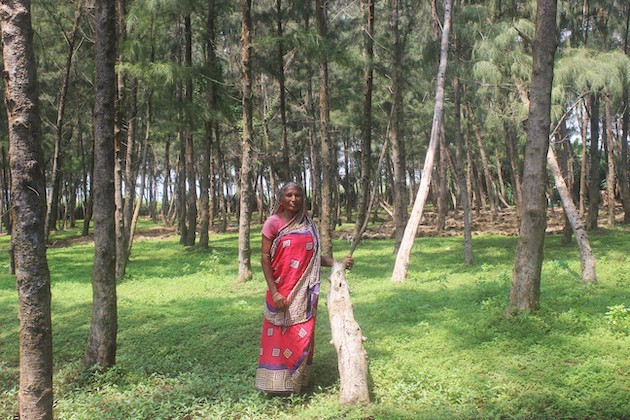
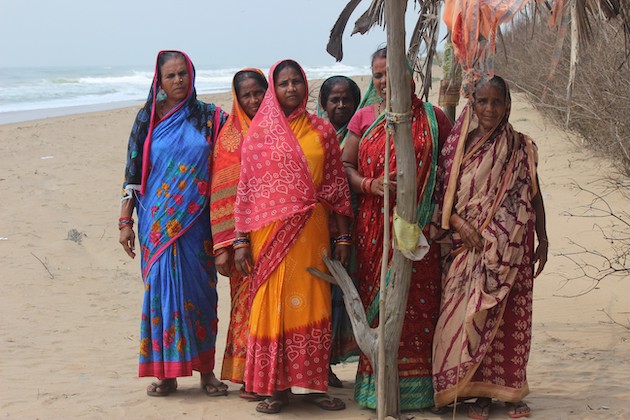

Climate Events More Frequent, Intense, and the Sea Keeps Getting Closer
But growing tree shields is a daunting exercise against a wounded, intermittently raging ocean. It is a handful of strong-willed women pitted against climate events getting more frequent and more intense from a rapidly warming sea. Odisha has encountered 10 cyclones in a span of 22 years from 1999 to 2021, with frequency rising over earlier decades, according to data from the Odisha State Disaster Management Authority (OSDMA), which works to reduce disaster risk.
More broadly, the Indian subcontinent has witnessed more than 478 extreme events since 1970, whose frequency has accelerated after 2005, IPS had earlier reported.
But another phenomenon, more insidiously devastating, is creeping in on Tandahara.
Sitting on a cemented platform under the shade of an ageing banyan tree, there are several elders who share how the sea has moved closer. Remembering over five decades back, 70-year-old Tahali Kalia Gopal Behera narrated to IPS, “When I was 18, we youngsters went to the sea to catch the red beach crabs. We carried our lunch and left home in the morning, returning only in the evening. Those days, the sea was more than 3 kilometres away.”
“The sea has eaten away 20 hectares of our village land,” Bidyadhar Bhuyan, another elderly man, said.
Of Odisha State’s over the 480-kilometre coastline, a high 79 percent has experienced drastic modification.
The State’s coastline change trend shows 21 percent has been subject to erosion, and 51 percent is impacted by accretion. Based on 26 years of satellite images, the 2018 study by the National Centre for Coastal Research of Earth Sciences Ministry remains the latest using such extensive data.
Odisha’s Puri province, where sea-front villages like Tandahara face the brunt, experienced the highest accretion on 110 km of its total 140 km shore length, this study said.
Coastal accretion is the gradual increase or acquisition of land by the sea. It occurs through washing up sand, soil, or silt. Erosion is the gradual washing away of land along the shoreline.
While erosion-accretion phenomena are natural, climate disasters and persisting low-pressure events that cause turbulent seas are increasing ecological imbalance, according to an OSDMA expert.
“When I married and came to the village, there were sand dunes stretching all the way,” remembered 46-year-old Mallika. “Now there’s hardly any beach left for dunes to stand; only the shore sands are rising higher.”
So close is the sea now that this year, 2023, even without any major low-pressure event, sea-water ingress has cut a 100-metre channel into pastureland on the village outskirt, Bhuyan added.
Oxford University research from across 52 sites worldwide on ‘nature-based solutions’ said coastal forest walls, mangroves and coral reefs cause waves to break before they hit the shore or ingress towards human habitats, lowering both the force and height of the swell and in the process reducing the likelihood of the sea breaching over into people’s land.
The study found that natural habitats were 2-5 times more cost-effective than engineered structures, like the geotextile tube installed in another affected district in Odisha, which was in tatters within 10 years. These (like Tandahara’s bio-wall) can help to protect from climate change impacts while slowing further warming (by carbon sequestration), supporting biodiversity, and securing ecosystem services, researchers widely believe.
Of Bulls, Goats and Other Challenges
As the Bay of Bengal became a hotspot for tropical storms and waves inched closer to Tandahara, coating salty mist day and night on everything, their staple rice crops began failing. Employable males migrated out.
Left behind with children and ageing parents to make ends meet were again the women. They began goat-keeping. The 108 households have no less than 500 goats today.
One adult goat weighing 15kg can easily fetch up to INR 8000 (USD 96.3), extra during festive seasons.
Handsome returns, yes, but also the biggest daily menace to women’s Casuarina walls.
“Until saplings are at least 5 feet tall and out of reach of the ever-hungry goats, we need to protect them. We patrol in groups of three, morning and afternoon,” elderly Harkamani Swain said.
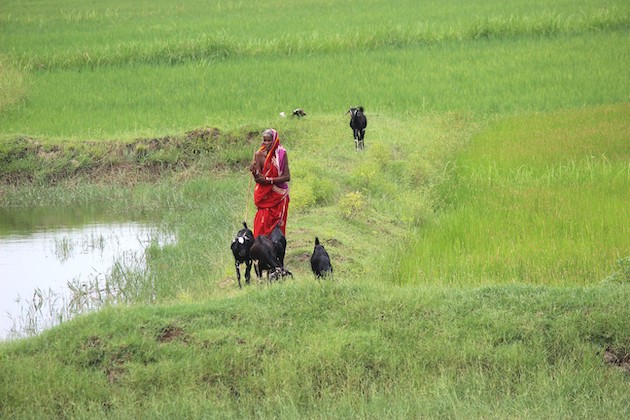
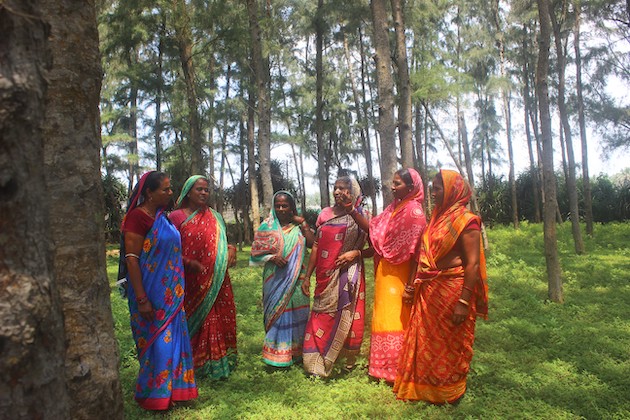
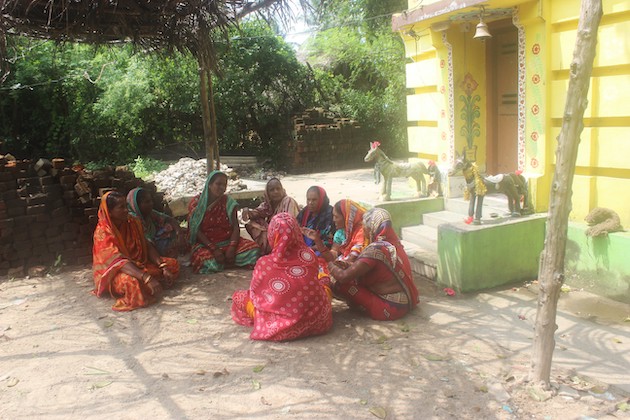
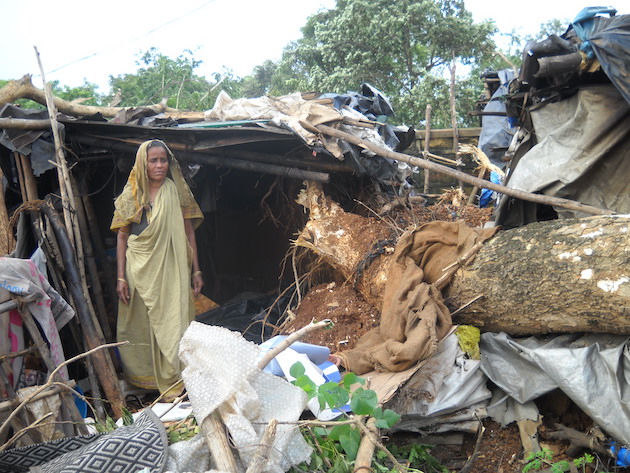
Rout walks on purposefully; it’s difficult to keep up with her, traversing over uneven abandoned paddy fields. She is going to check if any goats or the village bull have walked in to nibble at the new saplings planted under the government’s forestry scheme earlier in August this year when rains came.
If she espies the bull amidst the plants, she’ll holler, and the women will rush and help chase it out.
“If cattle destroy the plants, their owners have to pay a 100 rupees (USD 1.2) penalty, Rout explains, sighing in relief on seeing no intruder. “To get a hungry bull off the plantation requires more than one woman. If a help call is shouted out, but the group member whose house is closest does not respond, they are charged 100 rupees as well,” she explains how strict community rules have helped them grow the tree wall.
Seeing their zeal, in 2000, the forestry officials mentored them to form a village Forest Protection Committee. They were provided, one-time and free of cost, several large party-sized ironware pots worth 60,000 rupees (USD 722.8) to rent out to village events and maintain bank funds.
“Were this active group not been looking after the coastal forest, even when the government plants and sometimes waters them too, they would not remain alive beyond a month. There is a strong sense of ownership instilled within them. With them, we have a true partnership,” a local supervisory-level government forest official told IPS, wishing not to be named as they were not allowed to speak to the media.
Green Walls Provide Direct and Indirect Income for an Entire Village
When forest officials came with saplings this monsoon, the nearby beach was littered with dead Casuarina stumps and branches left from an earlier storm and proliferating beach creepers. The women’s group offered to clear the large stretches. In return, they got to take home the dead wood.
“With the thinner branches, we were able to repair seaside fences,” Kanaka Behera told IPS. The official would otherwise have hired contractors’ men on wages. “We take ownership of the storm walls. We will patrol till the saplings are grown.”
Dead trees get used for roof beams of thatched cattle sheds and for firewood, fulfilling needs in rural households. Odisha government, since the 2013 Phailin storm, has provided concrete-roofed, brick-walled disaster-resilient houses within 5 km of high tide.
Under the thick canopy of Casuarinas, a rotting pile of hay lies in a corner. The women can grow two mushroom crops here from early July to late August. The dense thicket obstructs damaging rain directly falling on the delicate fungi; high humidity is just right for bountiful harvests, which income goes into the group’s bank account, used when members need funds urgently.
Rout points further afield at over 25 green net-cloth-covered betel vine bowers just behind the Casuarina thicket. The 8-feet high square bamboo bowers, locally called ‘bareja’, are shading structures creating a green-house environment for better quality betel leaves. It can fetch a good income but is a fragile cultivation. “Those ‘barejas’ stand because this thick line of Casuarinas stands against strong winds that can easily bring the structures down and deprive a quarter of our village households of their livelihood,” she said.
Most afternoons, with household chores and afternoon meals done, the women leave the village behind to sit in the quiet under the trees. Sometimes, they laugh together, sing even if tunelessly, as the birds call from the branches, used to their presence.
“These trees are today like our grown-up sons; they stand strong here, ready to protect us, giving us confidence and moments of contentment,” says the elderly Bengalata Rout, whose only son Ritu, 40 years old, is working as a computer clerk thousands of kilometres away in Surat in western India, holding on to a deeply grooved tree trunk. A widow, she lives with her daughter-in-law and two little grandsons.
Powerful Agents of Change United in Fighting More Than Just the Storms and Seas
The water from the borewells in Tandahara became progressively so salty that children, no matter how thirsty, would often refuse to drink. Water carried from the small groundwater pit never sufficed. Forced to drink increasingly salty water, stomach upset, nausea and skin irritation have become chronic.
Bonding together for the tree barrier has, over the years, given the women of Tandahara a sense of unity and empowerment, and they are changing the collective traditional mindset of the village as well.
Post-pandemic, taking the poor drinking water issue into their own hands, the traditionally village-bound women marched to the local-level government officer with bottles of the salty water they got from hand pumps and asked the officer to drink it. The officer was shocked at the confrontation from a group of village women but finally admitted the water was undrinkable and ordered water tankers to deliver to the village.
Water is, however, supplied only in April and May, peak summer months when local water turns saltier. Again, it is limited to daily just two buckets per household, even for large families. On repeated visits by the women, administration higher-ups even visited the village five months back, promised piped water, but work is yet to begin, said 29-year-old Gouri Padhi, who has been in school up to class ten and is more educated than the others.
Looking Ahead
“Communities already have the agency to adapt and make decisions in the face of change,” said the Global Resilience Partnership Report 2023, but often need support in the form of appropriate data, knowledge, information, and resources to further strengthen adaptation and resilience actions.
“As climate and other shocks become more frequent, severe and overlapping, it is urgent to become smarter and faster when it comes to building resilience,” Dina Esposito, Assistant to the Administrator for the Bureau for Resilience and Food Security, told IPS via email. “At USAID, we’re bringing innovative solutions, such as shock response monitoring systems, to build resilience and to measure impact so that we can learn and adapt as we go.”
For the women of Tandahara, resilience is found in their collective efforts to save their village.
While murmurs are growing stronger among elderly men to step back from the advancing sea and resettle their homes at a safe distance. Two neighbouring villages have already left, illegally squatting on forest land, they point out.
“True, whenever the winds wail, my heart palpitates with dread; I think today all will end. When the government mobile alerts shriek, we flee to the two-storied storm shelter with our cattle. But we will not abandon our ancestral village,” Rout says firmly. “We will do whatever it takes to make it safer, but we will not leave,” she echoes her group’s stand on this crucial issue. Many of the younger generation youth listening nod in agreement.
IPS UN Bureau Report
Follow @IPSNewsUNBureau
Follow IPS News UN Bureau on Instagram
© Inter Press Service (2023) — All Rights ReservedOriginal source: Inter Press Service
Check out our Latest News and Follow us at Facebook
Original Source

